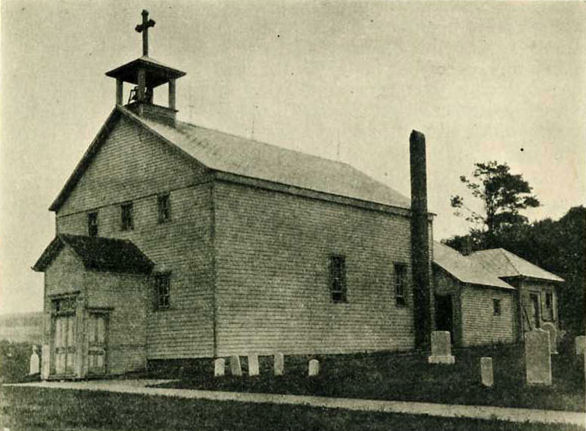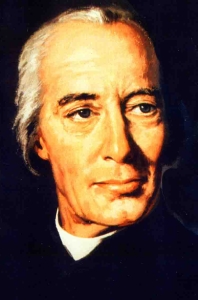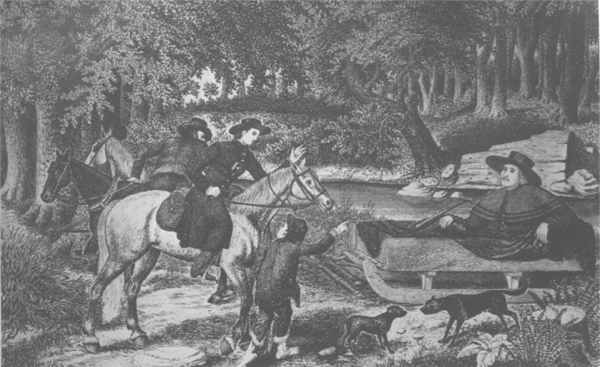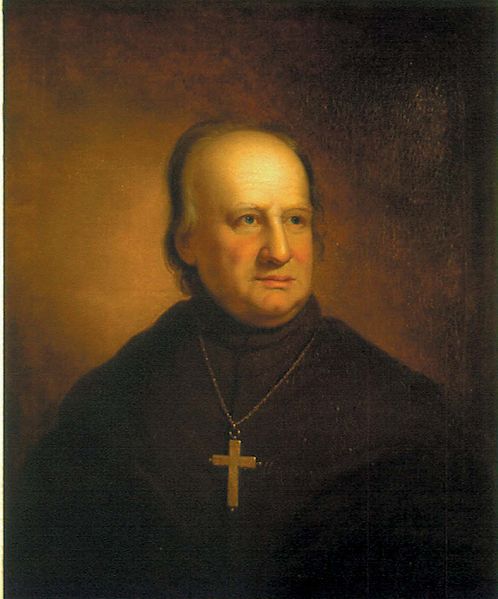Demetrius Augustine Gallitzin
Prince, priest, and missionary, born at The Hague, Holland, 22 December, 1770; died at Loretto, Pennsylvania, U.S.A., 6 May, 1840. He was a scion of one of the oldest, wealthiest, and most illustrious families of Russia. His father, Prince Demetrius Gallitzin (d. 16 March, 1803), Russian ambassador to Holland at the time of his son’s birth, had been previously for fourteen years Russian ambassador to France, and was an intimate acquaintance of Diderot, Voltaire, d’Alembert, and other rationalists of the day. Though nominally an Orthodox Russian, he accepted and openly professed the principles of an infidel philosophy. On 28 August, 1768, he married in Aachen the Countess Amalie, only daughter of the then celebrated Prussian Field-Marshal von Schmettau. Her mother, Baroness von Ruffert, being a Catholic, Amalie was baptized in the Catholic Church, but her religious education was neglected, and it was not until 1786 that she became a fervent Catholic, which she remained until her death, 27 April, 1806.
Little attention was paid to the religious education of Demetrius, who was born and baptized in the Greek Orthodox Church. In youth his most constant companion was Frederick William, son of William V, then reigning Stadtholder of the Netherlands. This friendship continued even after Frederick William became King of the Netherlands and Duke of Luxemburg as William I. Almost from his infancy the young prince was subjected to rigid discipline, and his intellectual faculties, trained by the best masters of the age, reached their fullest development. When about seventeen he became a sincere Catholic, and to please his mother, whose birth (1748), marriage (1768), and First Holy Communion (1786) occurred on 28 August, the feast of St. Augustine, assumed at confirmation that name, and thereafter wrote his name Demetrius Augustine. After finishing his education he was appointed aide-de-camp to the Austrian General von Lillien, but as there was no opportunity for him to continue a military career his parents resolved that he should spend two years in traveling through America, the West Indies, and other foreign lands. Provided with letters of introduction to Bishop Carroll of Baltimore, and accompanied by his tutor, Father Brosius, afterwards a prominent missionary in the United States, he embarked at Rotterdam, Holland, 18 August, 1792, and landed in Baltimore, 28 October. To avoid the inconvenience and expense of traveling as a Russian prince, he assumed the name of Schmet, or Smith, and for many years was known in the United States as Augustine Smith. Soon after arriving at Baltimore, he was deeply impressed with the needs of the Church in America. He resolved to devote his fortune and life to the salvation of souls in the country of his adoption. Despite the objections of his relatives and friends in Europe, he, with the approval of Bishop Carroll, entered St. Mary’s Seminary, Baltimore, as one of its first students, it having been founded the previous year (1791) by Sulpician priests, refugees from France. On 18 March, 1795, he was ordained priest, being the first to receive in the limits of the original thirteen of the United States all the orders from tonsure to priesthood.
In 1788 Captain Michael McGuire, an officer in the Revolutionary army, purchased about 1200 acres of land near the summit of the Alleghenies, in what is now Cambria County, Pennsylvania, and was the first white man to establish a residence within the limits of that county. He brought his family from Maryland and built his log-cabin in the valley below the site of the present town of Loretto, in the midst of a dense forest which covered all that portion of the State. His nearest neighbours were fully twenty miles distant. Soon relatives and friends followed from Maryland, established themselves in the vicinity, and formed what came to be known far and wide as McGuire’s Settlement, later called Clearfield, the lands lying on the headwaters of Clearfield Creek. Some years after his arrival Father Gallitzin named it Loretto, after the city of Loreto in Italy; but it was not until 1816 that he laid out the town and caused the plan of lots to be recorded in the county archives. Captain McGuire died in 1;793, bequeathing to Bishop Carroll four hundred acres of his land in trust for the benefit of the resident clergy who, he hoped, would be appointed to provide for the spiritual wants of his growing colony. He was the first to be buried in the portion of this land set aside for a cemetery, which Father Brosius consecrated on one of his early visits to the settlement.

Saint Joseph Mission Church. This little mission church, the fruit of the zealous labor of the Catholic Pioneers, was the center of Catholicity in Northern Cambria County between 1830 and 1849. Father Gallitzin dedicated this log church in honor of St. Joseph on Sunday, October 10, 1830, celebrated Mass and baptized eleven children.
Father Gallitzin first exercised his ministry at Baltimore and in the scattered missions of southern Pennsylvania and northern Maryland and Virginia. In 1796, while stationed at Conewago, Pennsylvania, he received a sick-call to attend a Mrs. John Burgoon, a Protestant, who lived at McGuire’s Settlement, about one hundred and fifty miles distant, and who ardently desired to become a Catholic before her death. Father Gallitzin immediately started on the long journey, instructed Mrs. Burgoon, and received her into the Church. During this visit to the Alleghenies he conceived the idea of forming there a Catholic settlement. In preparation therefor, he invested his means (considerable at that time) in the purchase of land adjoining the four hundred acres donated to the Church, and at the urgent request of the little mountain colony obtained from Bishop Carroll permission to fix his permanent residence there with jurisdiction extending over a territory with a radius of over one hundred miles. In the summer of 1799 he commenced his career as pioneer priest of the Alleghenies. His first care was to erect a church and house of logs, hewn from the immense pine trees of the surrounding forest. In a letter to Bishop Carroll, dated 9 February, 1800, he writes: “Our church, which was only begun in harvest, got finished fit for service the night before Christmas. It is about 44 feet long by 25, built of white pine logs with a very good shingle roof. I kept service in it at Christmas for the first time. There is also a house built for me, 16 feet by 14, besides a little kitchen and a stable.” While the church and house were being constructed, he said Mass for the few Catholics of the settlement in the log house, erected two years previously by Luke McGuire, the elder son of the captain. That house is still standing (1909) and serves as a residence for the descendants, in direct male line, of the founder of McGuire’s Settlement. To accommodate the increasing influx of Catholic colonists, Father Gallitzin in 1808 enlarged the log church to almost double its former capacity, and as the population continued to increase, he took down the log building in 1817, and on the same site erected a frame church, forty by thirty feet, which served as the parish church until 1853.
Father Heyden, one of Father Gallitzin’s biographers, writes (1869): “What now constitutes the dioceses of Pittsburg, Erie, and a large part of the Harrisburg new episcopal see, was then the missionary field of a single priest, Rev. Prince Gallitzin. If we except the station at Youngstown, Westmoreland County, where the Rev. Mr. Browers had settled a few years before, there was not, from Conewago in Adams County to Lake Erie-from the Susquehanna to the Potomac-a solitary priest, church, or religious establishment of any kind, when he opened his missionary career. From this statement we may conceive some idea of the incredible privations and toils which he had to encounter in visiting the various widely remote points where some few Catholics happened to reside.” As early as 1800, and frequently thereafter, he wrote to Bishop Carroll, begging that one or more priests be sent to share his burdens. And so for more than twenty years he was obliged to perform, unassisted, a work which would have proved onerous for several.
He was not only the good shepherd of his multiplying flock; he was also in a particular manner their worldly benefactor. Following out his idea of establishing a Catholic colony at the place which he named Loretto, and which he made the cradle of Catholicity in Western Pennsylvania, he, by means of remittances from Germany and loans contracted on the strength of his expectations, purchased large portions of land adjoining the settlement, which he sold in small tracts to the incoming colonists at a very low rate and on easy terms. For much of this land he was never repaid. Moreover, he built, at his own expense, saw-mills, grist-mills, and tanneries, and established other industries for the material benefit of his flock. In accomplishing all this he necessarily burdened himself with a heavy personal debt; not imprudently, however, for he had received solemn assurances that he would obtain a portion of his father’s large estate, as well as his share of his mother’s bequest. The Russian Government, nevertheless, disinherited him for becoming a Catholic and a priest, and the German prince who had married his sister squandered both his and her inheritance. In these circumstances, he was compelled, in 1827, to appeal to the charitable public; the appeal was endorsed by Charles Carroll of Carrollton, who headed the list with a subscription of one hundred dollars; on the list stands the name of Cardinal Cappellari, afterwards Pope Gregory XVI, who subscribed two hundred dollars. Yet it was not until near the close of his life that the burden of debt was finally lifted. During the forty-one years of his pastorate in the Alleghenies, he never received a cent of salary; he maintained himself, his household, and the many orphans whom he sheltered, and abundantly supplied the wants of the needy among his flock out of the produce of his farm, which by his intelligent method of cultivation became very productive. It is estimated that he expended $150,000 of his inheritance, a small portion of the amount that should rightly have come to him, but an immense sum for the times in which he lived, in the establishment of his Catholic colony on the Alleghenies. For some years (1804-1807) he was rewarded with ingratitude. His actions were misconstrued, his words and writings misinterpreted, his character vilified, his honour attacked, and even violent hands were laid on his person, and all this by members of his own flock. But, with the encouragement of his bishop and the aid of the civil courts, he brought his defamers to acknowledge their guilt, for which they voluntarily and publicly made full reparation before their fellow Catholics in the Loretto church.
For fourteen years after his ordination Father Gallitzin was known to the general public as Augustine Smith. This was the name which he subscribed to all his legal papers and to his entries in the parish register of baptisms and marriages. But, fearing serious difficulties in the future, at his request, on 16 Dec., 1809, the Pennsylvania legislature validated the acts and purchases made under that assumed name, and legalized the resumption of his real name. Notwithstanding his varied labours, Father Gallitzin found time to publish several valuable tracts in favour of the Catholic cause. He was the first in the United States to enter the lists of controversy in defence of the Church; ;he was provoked thereto by a sermon delivered on Thanksgiving Day, 1814, in Huntingdon, Pennsylvania, by a certain minister who went out of his way to attack what he called “popery”. Repelling this attack, Father Gallitzin first published his “Defense of Catholic Principles”, which ran through several editions and was the means of many conversions. This was followed by “A Letter on the Holy Scriptures” and “An Appeal to the Protestant Public”.
For twenty years Father Gallitzin had laboured alone in a vast mission whose Catholic population was constantly increasing; in 1834, when Father Lemke was sent to his assistance and was assigned the northern part of Cambria County as his sphere of action, the parish of Loretto was restricted within comparatively narrow limits. In the meantime Father Gallitzin’s reputation for sanctity, the fame of his talents, and the account of his labours had spread far and wide; and it was his deep humility as well as his love for his community that prevented his advancement to the honours of the Church. He accepted the office of Vicar-General for Western Pennsylvania, conferred on him by Bishop Conwell of Philadelphia, in 1827, because he felt that in that office he could promote the interests of the Church; but he strongly resisted the proposals to nominate him for the position of first Bishop of Cincinnati and first Bishop of Detroit. For many years before his death he lived in the hope of seeing Loretto made an episcopal see, for Loretto was then a flourishing mission and the centre of a constantly increasing Catholic population, while Pittsburg was a small town containing but few Catholics. After forty-one years spent on the rugged heights of the Alleghenies, he died as he had lived, poor. On coming to McGuire’s Settlement he found a dense wilderness; he left it dotted with fertile farms. As an evidence of his religious labours in Pennsylvania, it may be stated that within a radius of fifteen miles from the spot on which in 1799 he built his log church there are now no less than twenty-one flourishing parishes, thirty-three priests, and four religious and educational institutions. He was buried, according to his desire, midway between his residence and the church (they were about thirty feet apart); in 1847 his remains were transferred to a vault in a field nearer the town, over which a ;humble monument was erected out of squared blocks of rough mountain stone. In 1891 his remains were taken from the decayed coffin of cherry wood and placed in a metallic casket; in 1899, on the occasion of the centenary celebration of the foundation of the Loretto Mission, the rude monument was capped by a pedestal of granite, and this in turn by a bronze statue of the prince-priest, donated by Charles M. Schwab, who also built the large stone church, which was solemnly consecrated, 2 Oct., 1901.
LEMKE, Leben und Wirken (Münster, 1861); HEYDEN, Life and Character of Rev. Prince Demetrius A. de Gallitzin (Baltimore, 1869); BROWNSON, Life of D. A. Gallitzin, Prince and Priest (New York, 1872); KITTELL, Souvenir of Loretto Centenary (Cresson, Pa., 1899); KART in Catholic World (New York, 1895), LXI; MIDDLETON in Am. Cath. Hist. Mag. (Philadelphia, 1893), IV; PISE in U. S. Cath. Hist. Mag. (New York, 1890), III; HEUSER in American Catholic Historical Magazine (Philadelphia, 1895), VI.
FERDINAND KITTELL (Catholic Encyclopedia)











